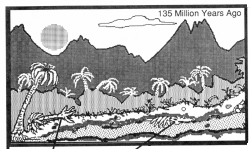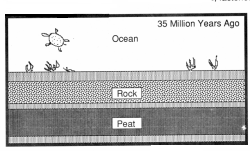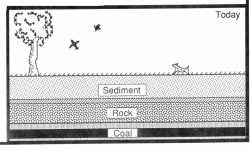
Graphics for Fossil Fuels - Importance and Formation


Using Energy
Each person, animal, plant, and machine uses energy. We need energy to run, think, grow, move a leg, or run a motor.
The sources for this energy can come in many different forms.
People and animals eat some sort of food, such as corn or meat.
Plants get their energy from the sun and soil.
A car is a machine that burns a fuel, such as gasoline, to power its engine. Gasoline comes from petroleum.
When we turn on the lights in our homes or schools we are using electricity to power the light bulbs. Over half of the electricity in the U.S. is produced by burning a fuel called "coal" that usually looks like a black rock.
When we take a got shower we use water that is heated by natural gas.
Coal, natural gas, and petroleum make up a group of fuels called "Fossil Energy." Just as the plant and animal fossils seen in museums today, these fossil fuels were created from plants and animals that lived and died millions of years ago.
| The Human Body: That Marvelous Machine | |
 | Your Body is Like a Very Complex Machine. You Need Fuel to Run Your Engine. Energy is the Fuel You Use. People Get Energy From Eating Food, Such as Corn. Cars Need Energy Too. They Use Gasoline, A Product Made From A Fossil Fuel Called "Petroleum." |
| Gasoline, A Liquid Fossil Fuel Product made From Petroleum, Is Used As Energy To Power Cars | ||||
 | ||||
| Petroleum began as Prehistoric sea animals died and were buried on the ocean floor. | During the millions of years that followed, the animal remains were continually buried by more and more materials and they became deeper in the earth where heat and pressure changed the remains into petroleum and natural gas. | Today we drill down in the earth to rock formations that contain crude oil (Petroleum) and Natural Gas. | Once the Crude Oil is out of the ground it is sent to be separated into various products at a refinery. | Cars run on energy produced by burning a petroleum product called "Gasoline". |

 | ||||
| Coal began forming from the remains of plants that died during prehistoric times long before the dinosaurs roamed the Earth. | After the plants were buried deep in the Earth, heat and pressure combined to turn the plant remains into a fossil fuel rock called "coal". | Coal can be obtained by digging it out of the Earth either at the surface of the ground or deep underground. | Coal can be burned as an energy fuel by your power company in order to produce electricity. | Our lights are powered by electricity, a form of energy that can be generated by burning coal. |
| How Was Coal Formed? |  | Fossil fuels (coal, natural gas, and petroleum) were formed from plants and animals that lived and died millions of years ago. For example, some coal began forming from plants that died millions of years before the dinosaurs roamed the Earth. |
| Peat is an early state reached before coal is completely formed. |  | As the years passed, the remains of these dead plants were buried under many layers of mud, water, sand, and rock. Pressure of the weight of the upper layers and heat within the earth caused the dead plants to change slowly into the coal we use today to produce electricity to power the lights in our homes, offices, factories, and schools. |
| To create 1 foot layer of coal, at least 10 feet of prehistoric plant remains were needed. |  | When you pick up a piece of coal, you are holding one of the oldest plant fossils on Earth. Similar to coal, natural gas and petroleum began forming from tiny sea organisms that died millions of years ago. Therefore, these energy sources, coal, natural gas, and petroleum, have been named "fossil" fuels. |
How Was Coal Formed?
Fossil Fuels (coal, natural gas, and petroleum) were formed from plants and animals that lived and died millions of years ago. After they died, their remains were covered by more and more layers of dirt, rock and other debris deposited by wind, floods, volcanic eruptions, etc. until they were buried deep in the ground. As millions of years passed, the Earth continued to change. New plants and animals developed and then died out (such as the dinosaurs).
Deep in the ground, the plant and animal remains were changing too. They were being squeezed by the pressure of the weight of the layers on top of them and were being cooked by the heat deep in the ground. These prehistoric plants and animals were becoming Fossil Fuels. Today the coal, natural gas, or petroleum we use to power our cars, air conditioners, buses, lights, etc. are called "Fossil Fuels" because they were made from plants and animals that lived during geologic periods millions of years ago.
Even the fossils of dinosaurs seen in museums are not as old as the coal we mine today because coal began forming millions of years before the dinosaurs started roaming the Earth. When you pick up a piece of coal you are holding one of the oldest fossils on Earth.

Underground Geological Layers of the Earth
(The layers may be composed of sediment, coal, granite, sandstone, gold, limestone, copper, slate, silver, or bedrock. Each new layer contributed by wind, water, volcanic eruptions, animals, etc. adds more weight on the lower layers. This weight causes the lower layers to be compressed and become harder and harder until they form rock. Water, natural gas, or petroleum may also be trapped between the layers. It is up to geologists to determine where valuable resources can be found underground.)
The layers under the surface of the ground may be composed of coal, gold, sandstone, granite, slate, silver,copper, limestone, or bedrock. Each new layer contributed by plants, animals, volcanic eruptions, water, wind, etc. add more weight on the lower layers. This weight causes the lower layers to be compressed and become harder and harder until they form rock. The layers may buckle or crack due to volcanic eruptions underground leaving the layers in waves (anticline formations) or sliding over the other (fault formations). Water, natural gas, or petroleum may be trapped between the layers. It is up to geologists to determine where valuable resources can be found underground.
Suggested activity: Designate a small surface area on a shelf or table (be sure to clearly mark off the area so it will not be cleaned, covered, or moved). Check each day to see how much dust and debris have settled from the air on this sectional. Relate how quickly a layer of dust, pollen, dirt, etc. collected in your experiment to what happens each day, week, year, century, etc. on the surface of the Earth. Discuss 1) how wind or water may carry and then deposit various materials and 2) how these materials over long periods of time (or short periods in the case of natural phenomena such as volcanic eruptions) form the layers that make up the crust of the Earth.
| Lesson 1 Word List | ||
| Do you know what these words mean? | ||
| Can you spell the words without looking at the list? | ||
| Can you find where the words are used on these pages in Dinosaurs & Power Plants? | ||
| PAGE 1 dinosaurs lifetimes fossil fuels natural gas liquid debris natural events earthquakes decomposed combination conditions Exposed sediment compress process dense contributed | power plants televisions coal three states of matter gas prehistoric volcanic eruptions materials underground animal remains temperature decaying vanished silt rock formations seeping | energy computers petroleum solid million Earth's crust landslides receded organic wood debris pressure organisms bacteria regions caprock surface |
| PAGE 14 ("Energy Equivalents") equivalents oz. (ounce) | bicycling Btu | average sandwich |

ENERGY USES
List 3 Energy using activities of a dinosaur.
List 3 of your activities that require your body to have energy.
List 3 things that are powered by electricity or coal, natural gas, or petroleum products.